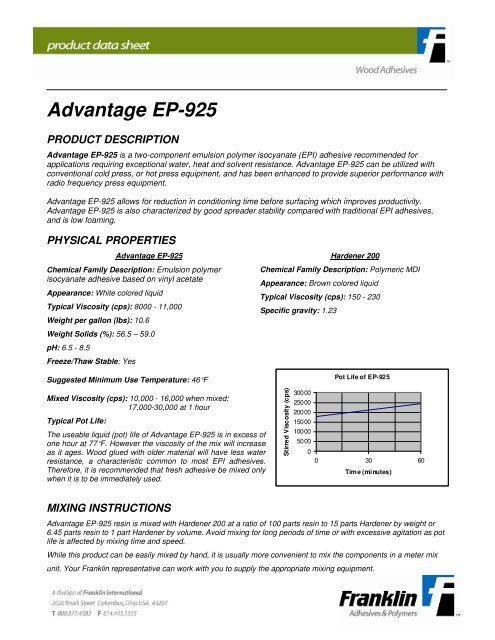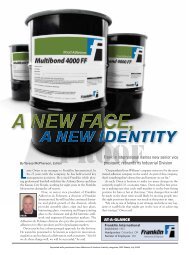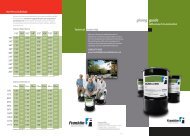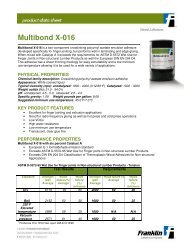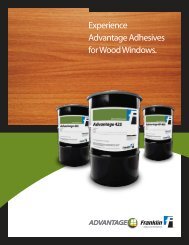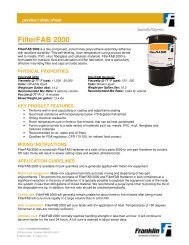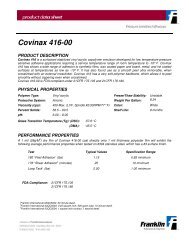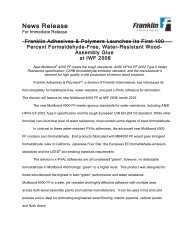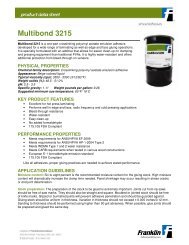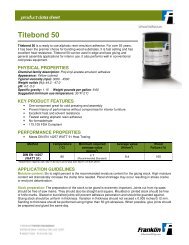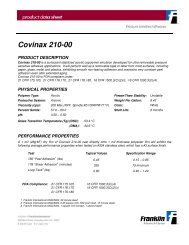Advantage EP-925 - Franklin Adhesives and Polymers
Advantage EP-925 - Franklin Adhesives and Polymers
Advantage EP-925 - Franklin Adhesives and Polymers
Create successful ePaper yourself
Turn your PDF publications into a flip-book with our unique Google optimized e-Paper software.
_<br />
<strong>Advantage</strong> <strong>EP</strong>-<strong>925</strong><br />
PRODUCT DESCRIPTION<br />
<strong>Advantage</strong> <strong>EP</strong>-<strong>925</strong> is a two-component emulsion polymer isocyanate (<strong>EP</strong>I) adhesive recommended for<br />
applications requiring exceptional water, heat <strong>and</strong> solvent resistance. <strong>Advantage</strong> <strong>EP</strong>-<strong>925</strong> can be utilized with<br />
conventional cold press, or hot press equipment, <strong>and</strong> has been enhanced to provide superior performance with<br />
radio frequency press equipment.<br />
<strong>Advantage</strong> <strong>EP</strong>-<strong>925</strong> allows for reduction in conditioning time before surfacing which improves productivity.<br />
<strong>Advantage</strong> <strong>EP</strong>-<strong>925</strong> is also characterized by good spreader stability compared with traditional <strong>EP</strong>I adhesives,<br />
<strong>and</strong> is low foaming.<br />
PHYSICAL PROPERTIES<br />
<strong>Advantage</strong> <strong>EP</strong>-<strong>925</strong><br />
Chemical Family Description: Emulsion polymer<br />
isocyanate adhesive based on vinyl acetate<br />
Appearance: White colored liquid<br />
Typical Viscosity (cps): 8000 - 11,000<br />
Weight per gallon (lbs): 10.6<br />
Hardener 200<br />
Chemical Family Description: Polymeric MDI<br />
Appearance: Brown colored liquid<br />
Typical Viscosity (cps): 150 - 230<br />
Specific gravity: 1.23<br />
Weight Solids (%): 56.5 – 59.0<br />
pH: 6.5 - 8.5<br />
Freeze/Thaw Stable: Yes<br />
Suggested Minimum Use Temperature: 46°F<br />
Pot Life of <strong>EP</strong>-<strong>925</strong><br />
Mixed Viscosity (cps): 10,000 - 16,000 when mixed;<br />
17,000-30,000 at 1 hour<br />
Typical Pot Life:<br />
The useable liquid (pot) life of <strong>Advantage</strong> <strong>EP</strong>-<strong>925</strong> is in excess of<br />
one hour at 77°F. However the viscosity of the mix will increase<br />
as it ages. Wood glued with older material will have less water<br />
resistance, a characteristic common to most <strong>EP</strong>I adhesives.<br />
Therefore, it is recommended that fresh adhesive be mixed only<br />
when it is to be immediately used.<br />
Stirred Viscosity (cps)<br />
30000<br />
25000<br />
20000<br />
15000<br />
10000<br />
5000<br />
0<br />
0 30 60<br />
Time (minutes)<br />
MIXING INSTRUCTIONS<br />
<strong>Advantage</strong> <strong>EP</strong>-<strong>925</strong> resin is mixed with Hardener 200 at a ratio of 100 parts resin to 15 parts Hardener by weight or<br />
6.45 parts resin to 1 part Hardener by volume. Avoid mixing for long periods of time or with excessive agitation as pot<br />
life is affected by mixing time <strong>and</strong> speed.<br />
While this product can be easily mixed by h<strong>and</strong>, it is usually more convenient to mix the components in a meter mix<br />
unit. Your <strong>Franklin</strong> representative can work with you to supply the appropriate mixing equipment.
Page 2 of 4<br />
APPLICATION GUIDELINES<br />
Moisture Content: Six to ten percent is the recommended moisture content for the gluing stock. Higher<br />
moisture content will increase the clamp time needed. Additionally, moisture content should mirror as closely as<br />
possible that which will be experienced in the end use market for the wood product being manufactured.<br />
Stock Preparation: The preparation of the stock to be glued is extremely important. Joints cut from rip saws<br />
should be free of saw marks. They should also be straight <strong>and</strong> square. Moulded or jointed stock should be free<br />
of knife marks. Glazed or burnished joints will prevent adhesive penetration <strong>and</strong> should be avoided. When<br />
possible, glue joints should be prepared <strong>and</strong> glued the same day. Gluing stock should be uniform in thickness.<br />
Variation in thickness should not exceed ± 0.005”. S<strong>and</strong>ing to thickness should be performed using higher than<br />
50 grit abrasives. Bowing of staves used in edge gluing should be kept to a minimum, typically less than 0.050”<br />
end to end.<br />
Spread Rate: The recommended adhesive coating layer is the same as for most PVA products or<br />
approximately 0.007” in thickness. <strong>EP</strong>I adhesives have superior gap filling properties due to their higher percent<br />
solids content. While <strong>Advantage</strong> <strong>EP</strong>-<strong>925</strong> has higher percent solids content than most PVA adhesives, it also<br />
has a higher specific gravity than PVA. This means that in order to apply the same 0.2 mm thickness layer of<br />
wet adhesive as for PVA, a higher gram weight of adhesive should be applied. Generally, 200 g/m² of glue line<br />
is adequate.<br />
Conveyorized spreaders are commonly used in edge-gluing applications. Adjust the applicator to ensure<br />
complete coverage on the staves. One side application is adequate in most situations. Verify that adequate<br />
coverage exists by monitoring squeeze-out along the glue lines when the panels are under pressure.<br />
Clamping Pressure: Pressure is dependent upon the species or material to be glued <strong>and</strong> joint preparation.<br />
Direct contact of the gluing surfaces must be made to obtain maximum strength. Suggested pressures for<br />
various wood densities are 8-15 inches apart <strong>and</strong> 2 inches from the end of the panel to evenly distribute<br />
pressure along the entire length of the glue line.<br />
Press/clamp Time: A minimum press time of 30 minutes is recommended under ideal conditions when using<br />
soft wood species at moisture contents less than 8-10% <strong>and</strong> factory temperatures of 68°F. Longer press times<br />
will be required for higher density species, higher moisture contents <strong>and</strong> colder factory temperatures. It is<br />
recommended that optimum press times be determined in actual plant conditions recognizing that seasonal<br />
changes may lead to variable requirements.<br />
On dry, low density lumber, the press time recommended for <strong>Advantage</strong> <strong>EP</strong>-<strong>925</strong> will be similar to that obtainable<br />
when using Titebond 50. As moisture content of the gluing stock increases, <strong>Advantage</strong> <strong>EP</strong>-<strong>925</strong> can be expected<br />
to cure more rapidly than Titebond 50 under the same circumstances. This is related to the fact that: a) the<br />
resin+hardener mixture has a higher percent solids content than Titebond 50 <strong>and</strong> b) a reaction occurs between<br />
the hardener <strong>and</strong> moisture present on the wood surface, effectively reducing the moisture content in the joint<br />
region. Having reported this, we repeat our recommendation to determine optimum press time in actual plant<br />
conditions.<br />
Working pauses: The spreader should be kept running during pauses in production for lunch breaks, etc. to<br />
help extend the working life of the adhesive.<br />
Machining: Post-gluing conditioning is not unlike PVA products, although shorter curing times are frequently<br />
possible. We recommend that panels be allowed to condition at least six hours prior to additional processing.<br />
Cleanup: The foaming <strong>and</strong> cross-linking characteristics of <strong>EP</strong>I may cause blockages in the wastewater<br />
plumbing. Furthermore, there may be disposal concerns with the mixed product. It is recommended that the<br />
excess glue from the spreader <strong>and</strong> mixing containers be poured into a container <strong>and</strong> disposed of. Avoid sealing<br />
the container for at least 24 hours to permit <strong>EP</strong>I components to finish reacting. Glue pans <strong>and</strong> rollers may then<br />
be washed in warm water.
Page 3 of 4<br />
PERFORMANCE PROPERTIES<br />
Bond Strength <strong>and</strong> Radio Frequency Gluing Performance<br />
<strong>Advantage</strong> <strong>EP</strong>-<strong>925</strong> is formulated to provide higher<br />
immediate bond strengths than conventional <strong>EP</strong>I<br />
adhesives. A positive correlation exists between the<br />
adhesive’s electrical conductivity <strong>and</strong> its immediate bond<br />
strength upon removal from radio frequency press<br />
equipment – with higher conductivity resulting in higher<br />
immediate bond strengths.<br />
Reactite <strong>EP</strong>-920<br />
Conductivity<br />
1.69 (µ Mho)<br />
Japanese <strong>EP</strong>I (competitor) 1.87 (µ Mho)<br />
<strong>Advantage</strong> <strong>EP</strong>-<strong>925</strong> 4.25 (µ Mho)<br />
The table to the right compares the strength of glue bonds<br />
made using Reactite <strong>EP</strong>-920 <strong>and</strong> <strong>EP</strong>-<strong>925</strong>, tested<br />
immediately upon removal from the radio frequency gluing<br />
machine (blue bar) <strong>and</strong> for the same wood panel tested<br />
after 24 hours conditioning at 71°F <strong>and</strong> 50% relative<br />
humidity (maroon bar).<br />
ASTM D905 Shear Strength (lb/sq in)<br />
Radio Frequency Gluing Performance<br />
4000<br />
3500<br />
3000<br />
2500<br />
2000<br />
1500<br />
1000<br />
500<br />
0<br />
Reactite <strong>EP</strong>920 Reactite <strong>EP</strong><strong>925</strong><br />
Im mediate<br />
24 Hour<br />
Bonding Strength <strong>and</strong> Durability<br />
• Japanese Industrial St<strong>and</strong>ard Class 1, Grade 1: Pass<br />
(refer to chart for boiling water test results)<br />
• Japanese Agricultural Society (JAS) st<strong>and</strong>ard for<br />
glued laminated timber for fixture<br />
o Cold water soak delamination test: Pass<br />
o Boiling water soak delamination test: Pass<br />
• EN 204 Group D4: Pass<br />
o WATT 91: > 7N/mm2 (passed)<br />
• ASTM D-5751-99 Laminated Joint Testing:<br />
TECO 05-243A (SYP) <strong>and</strong> 05-243C (Radiata Pine)<br />
Strength (kgf/sq cm)<br />
90<br />
80<br />
70<br />
60<br />
50<br />
40<br />
30<br />
20<br />
10<br />
0<br />
Reactite <strong>EP</strong>-<strong>925</strong><br />
JIS 6806 Class 1 Grade 1<br />
Boiling Water Test<br />
Required Maple Birch<br />
Boil 4 hr; oven dry 40°C 20 hr;<br />
boil 4 hr; tested wet at 20°C
Page 4 of 4<br />
Bonding Strength <strong>and</strong> Durability (cont.)<br />
• ASTM D-905 Block Shear<br />
Tested after 7 days conditioning at 22 °C.<br />
Maple<br />
77°F 3990 psi - 61%WF<br />
149°F 3195 psi - 78%WF<br />
Room Temperature Speed of Set: 1.25 (Very Fast)<br />
HANDLING AND STORAGE<br />
Shelf Life: Six months at 70°F. Store in closed containers.<br />
Storage of Hardener: Hardener 200 is very susceptible to moisture. We recommend that it be kept in a sealed<br />
container. A desiccant or nitrogen blanket is recommended.<br />
Safety <strong>and</strong> Disposal: Hardener 200 is a polymeric isocyanate. Use of gloves <strong>and</strong> other protective equipment is<br />
recommended. Consult MSDS before use for additional information.<br />
IMPORTANT NOTICE TO CUSTOMER:<br />
The recommendations <strong>and</strong> data contained in this Product Data Sheet for use of this product are based on information <strong>Franklin</strong> believes to<br />
be reliable. They are offered in good faith without guarantee, as conditions <strong>and</strong> methods for use of our product by Customer <strong>and</strong> are beyond<br />
<strong>Franklin</strong>’s control. Customer should determine the suitability of the product for a particular application before adopting it on a commercial<br />
scale. Discoloration <strong>and</strong> checking of wood veneer materials may occur with use of the product. These occurrences range in appearance,<br />
color <strong>and</strong> may also vary depending upon the species of wood veneer to which the product is applied. Such discoloration <strong>and</strong> checking may<br />
appear during or after the manufacturing process which utilizes the product. Environmental conditions in some manufacturing plants <strong>and</strong><br />
end-use locations can contribute to discoloration <strong>and</strong> checking. Because such discoloration <strong>and</strong> checking are attributable to conditions<br />
beyond <strong>Franklin</strong>’s control, <strong>Franklin</strong> cannot assume any responsibility or liability for any discoloration <strong>and</strong>/or checking problems that might<br />
occur.<br />
All orders for <strong>Franklin</strong> products shall be subject to <strong>Franklin</strong> International, Inc.’s St<strong>and</strong>ard Terms <strong>and</strong> Conditions of Sale which may be found<br />
at http://www.franklini.com/Terms_<strong>and</strong>_Conditions.aspx (“St<strong>and</strong>ard Terms”). Different or additional terms proposed by Customer are<br />
expressly rejected <strong>and</strong> shall not become part of the agreement between Customer <strong>and</strong> <strong>Franklin</strong> International, Inc. with respect to any order.<br />
Contact <strong>Franklin</strong> International, Inc. immediately if you cannot access our St<strong>and</strong>ard Terms <strong>and</strong> we will provide you a copy upon request. Any<br />
sale of products by <strong>Franklin</strong> to Customer is expressly conditional upon Customer’s consent to the St<strong>and</strong>ard Terms, <strong>and</strong> Customer’s<br />
acceptance of any performance by, or receipt of products from, <strong>Franklin</strong> International, Inc. shall constitute Customer’s acceptance of the<br />
St<strong>and</strong>ard Terms <strong>and</strong> Conditions of Sale.<br />
©Copyright 2010. All rights reserved. <strong>Franklin</strong> International. Revised 04/08/10.


